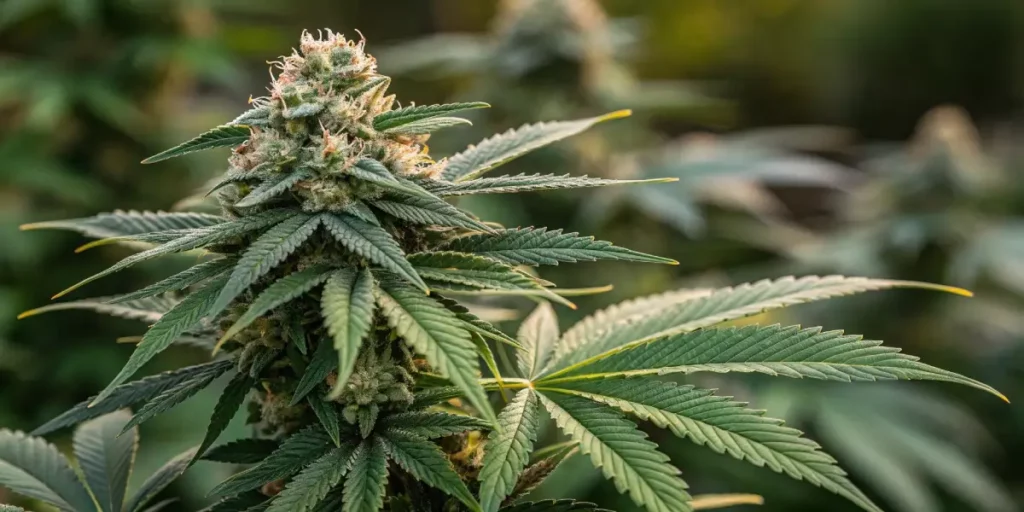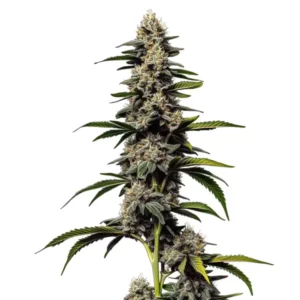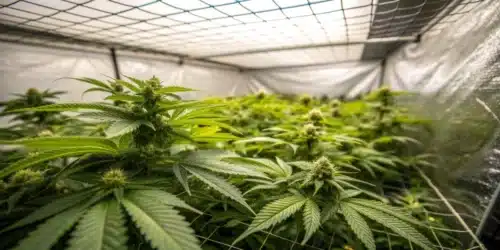Shiskaberry Weed Strain Description
Shiskaberry Weed Strain is a popular Indica-dominant cannabis strain known for its unique berry aroma, sweet flavors, and a smooth high that balances relaxation with focus. With THC levels ranging between 14% and 18%, Shiskaberry delivers a potent yet manageable high suitable for both beginners and experienced users. It is particularly valued for its ability to alleviate stress, fatigue, and muscle spasms.
Recommended Strains
Shiskaberry
 THC: 14 - 18%
THC: 14 - 18% Type of seed: Feminized
Type of seed: Feminized Phenotype: Mostly Indica
Phenotype: Mostly Indica Day to flower: 6 - 8 weeks
Day to flower: 6 - 8 weeks
The strain’s lineage includes the iconic DJ Short Blueberry and an Afghani strain, making this strain a genetic powerhouse. Its dense, resinous buds boast a mix of fruity and earthy flavors, which are enhanced by a rich terpene profile including Alpha-Humulene and Beta-Caryophyllene. For medical users, this strain is often chosen to help with pain relief, insomnia, and arthritis, making it a versatile option for those seeking both recreational and therapeutic benefits.
Environmental Requirements for Growing Shiskaberry Weed Seeds
Shiskaberry Strain thrives in a variety of environments but performs best in a controlled indoor setup where temperature and humidity can be closely monitored. For optimal growth, maintain temperatures between 70-80°F (21-27°C) during the day and slightly cooler temperatures at night to promote strong development. The flowering time of Shiskaberry is 8-10 weeks, and it benefits from stable conditions throughout the growth cycle.
Humidity control is crucial, particularly during the flowering phase, where high moisture levels can lead to mold or mildew on the dense buds. Aim to keep humidity levels between 40-50% to avoid these issues. Providing adequate ventilation is key to maintaining airflow, especially in indoor environments. For outdoor cultivation, Shiskaberry can be grown in sunny and warm climates, but extra care should be taken to shield the plants from heavy rains or excessive humidity.
Promos & Deals
Setting Up the Growing Space for Shiskaberry
Indoor Cannabis Cultivation
For indoor growers, selecting a grow tent or a dedicated grow room with controlled light and airflow is essential. Shiskaberry performs well in soil-based or hydroponic systems, provided that the pH levels are maintained between 6.0-6.5 for soil and 5.5-6.0 for hydroponics. Using reflective materials such as Mylar sheets in the grow space will help ensure that light reaches all parts of the plant evenly.
Shiskaberry’s medium height makes it suitable for smaller grow rooms. You can expect manageable growth without extensive stretching during the flowering phase. Use high-quality LED or HPS grow lights for optimal light penetration. During the vegetative stage, provide 18-20 hours of light daily and switch to 12 hours of light and 12 hours of darkness to trigger flowering.
Outdoor Cannabis Cultivation
In outdoor settings, Shiskaberry Kush Strain thrives in warm, sunny climates. It is recommended to plant in well-draining soil rich in organic nutrients. If you’re growing in regions with high humidity or frequent rainfall, consider using a greenhouse to protect the plants from excess moisture and temperature fluctuations. The strain responds well to basic plant training techniques such as low-stress training (LST), which can improve bud development by promoting even light distribution.
Given its dense bud structure, it’s important to monitor for mold, particularly in outdoor environments where airflow may be less controlled. Ensure that plants are spaced appropriately to allow air circulation between them.

Propagation and Germination of Shiskaberry Weed Strain
To achieve a successful germination process, follow these steps for Shiskaberry:
1. Select high-quality Shiskaberry feminized seeds from a reputable seed bank to ensure strong genetic potential and avoid male plants.
2. Begin the germination process by soaking the seeds in distilled water for 24-48 hours or using a damp paper towel method. Keep the temperature between 70-85°F (21-29°C) to promote optimal conditions for sprouting.
3. Once the seeds develop taproots, transfer them to a growing medium such as a seedling tray or small pots filled with well-draining soil or a light seedling mix. Place the seedlings in a warm, humid environment with indirect light for the first few days.
4. As the seedlings develop true leaves, gradually increase the light intensity and ensure the plants receive 18-20 hours of light daily during the vegetative stage. Once the seedlings are strong enough, they can be transplanted into larger containers or an outdoor growing space.
Vegetative Phase
During the vegetative stage, Shiskaberry plants will focus on developing a strong root system and foliage. To support this, provide a nutrient-rich fertilizer high in nitrogen (N) to encourage robust leaf and stem growth. The strain’s natural resilience makes it beginner-friendly, but regular monitoring of water and nutrient levels is still essential to avoid any nutrient deficiencies or excesses.
Low-stress training (LST) can help control the height of your Shiskaberry plants and promote lateral growth, which will maximize light exposure to all parts of the plant. This results in a more even canopy and better bud production during the flowering stage. Keep the plants well-hydrated but avoid waterlogging, as this can lead to root problems.
Flowering Phase
The flowering stage is where Shiskaberry truly shines. After 8-10 weeks of flowering, the strain will produce dense, resinous buds with a rich berry and fruity aroma. To initiate the flowering phase, switch the light cycle to 12 hours of light and 12 hours of darkness. As the buds develop, you may notice the aroma becoming more pronounced, requiring proper ventilation or odor control methods such as carbon filters if growing indoors.
During this stage, it’s essential to switch to a bloom-specific fertilizer with higher phosphorus (P) and potassium (K) levels. This will promote healthy bud formation and resin production. Keep an eye on humidity levels during the flowering stage to prevent mold or bud rot. Aim for humidity levels between 40-50% and ensure good airflow in the grow space.
Cannabis Fertilization and Nutrition for Shiskaberry Weed Strain
Shiskaberry requires a balanced nutrient regimen throughout its growth stages. During the vegetative stage, focus on fertilizers rich in nitrogen to support foliage growth. As the plants enter the flowering phase, transition to a bloom fertilizer that emphasizes phosphorus and potassium to promote healthy bud development and maximize yield.
Micronutrients such as calcium and magnesium are also important for maintaining overall plant health. Monitoring pH levels regularly will ensure proper nutrient absorption. In soil-based systems, aim for a pH range of 6.0-6.5, while in hydroponic systems, keep the pH between 5.5-6.0.
To improve flavor and overall quality, flush the plants with pure water during the final two weeks of flowering to remove any excess nutrients from the growing medium. This process enhances the smoothness and taste of the final harvest.
Pest and Disease Control for Growing Shiskaberry Weed Strain
Although Shiskaberry is known for its resilience, it is still susceptible to common cannabis pests and diseases. To protect your crop, regular inspections are necessary to identify and address any potential issues early. Pests such as spider mites, aphids, and thrips can be controlled using organic methods like neem oil or insecticidal soaps.
In outdoor settings, natural predators such as ladybugs can be introduced to manage pest populations. Ensuring proper airflow and humidity control is also essential for preventing mold and mildew, which can occur during the flowering phase due to the strain’s dense bud structure. Keeping the growing area clean and free of debris will also help reduce the risk of infestations.
Harvesting and Curing Shiskaberry Weed Strain
Proper harvesting and curing of Shiskaberry Weed Strain are crucial for preserving the aroma, flavor, and potency of your buds. The ideal time to harvest Shiskaberry is when the trichomes on the buds are mostly cloudy, with some turning amber. This indicates that the THC levels have peaked, and the effects will be balanced between a relaxing body high and a euphoric cerebral experience.
When you’re ready to harvest, use clean, sterilized scissors or pruning shears to cut the branches one by one. Be careful to handle the buds gently to avoid damaging the delicate trichomes, which contain most of the cannabinoids and terpenes. Trim the large fan leaves but leave the smaller sugar leaves intact, as they will continue to contribute to the resin content during the drying process.
Hang the trimmed branches upside down in a dark, well-ventilated room with a temperature of 60-70°F (15-21°C) and a humidity level of 50-60%. Ensure proper airflow to avoid mold formation, and allow the buds to dry over a period of 7-14 days, depending on the environment.
After the drying process is complete, carefully remove the buds from the stems and place them in airtight glass jars for curing. Open the jars daily during the first week to release excess moisture, gradually reducing the frequency over time. Curing typically takes 2-4 weeks, but longer curing times can further enhance the flavor and potency of the final product.

Is Shiskaberry Weed Strain Indica or Sativa?
It is a predominantly Indica strain with a genetic background that includes DJ Short Blueberry and Afghani. Its Indica dominance is reflected in the strain’s relaxing and calming effects, making it ideal for those seeking relief from stress, pain, or insomnia. Despite its Indica lineage, this strain also offers a mild cerebral high, providing focus and clarity alongside its physical relaxation. Growers also appreciate the shishkaberry strain flowering time, which is relatively short and suitable for both indoor and outdoor cultivation.
This combination of mental and physical effects makes Shiskaberry versatile, appealing to both recreational users looking for a soothing high and medicinal users who need relief from ailments like arthritis, muscle spasms, and fatigue.
Advantages of Growing Shiskaberry Weed Strain
- Beginner-friendly strain that is resilient and easy to cultivate.
- Produces medium to high yields with dense, resinous buds.
- Rich terpene profile, offering sweet, fruity, and berry flavors.
- Short flowering time of 8-10 weeks, making it ideal for growers seeking quicker harvests.
- Excellent therapeutic potential, especially for stress, pain relief, and insomnia.
Disadvantages of Growing Shiskaberry Weed Seeds
- Requires careful humidity control during the flowering phase due to its dense buds, which are prone to mold if not properly ventilated.
- Odor control may be necessary during flowering due to its strong berry and fruity aroma.
- May require additional support for branches due to the heavy weight of the buds.
Why Buy Shiskaberry Weed Strain
Shiskaberry Weed Strain is a great choice for cannabis enthusiasts for several reasons:
1. Potent, Balanced Effects: this strain provides a well-rounded experience, with a mix of physical relaxation and mental clarity. Its THC content, which ranges between 14% and 18%, makes it a versatile strain that can be enjoyed throughout the day or night.
2. Therapeutic Benefits: this strain’s relaxing effects make it highly effective for treating conditions such as stress, fatigue, and muscle spasms. It’s also commonly used by medical marijuana patients for pain relief and insomnia.
3. Delicious Flavor Profile: The strain’s sweet, fruity, and berry flavors, combined with its smooth smoke, make this strain a favorite for cannabis connoisseurs.
4. Short Flowering Time: Shiskaberry has a relatively short flowering time of 8-10 weeks, making it ideal for growers looking for a quick turnaround.
5. High Yields: Despite being beginner-friendly, it offers impressive yields when grown in optimal conditions, making it a rewarding strain for both novice and experienced growers.
Problems in Cultivating Shiskaberry Weed Strain
While it is relatively easy to grow, there are a few common issues that may arise during cultivation. Here are some problems to watch out for:
1. Mold and Mildew: Due to the strain’s dense bud structure, it is susceptible to mold and mildew if humidity levels are not controlled. Keep humidity between 40-50% during the flowering phase to prevent moisture-related issues.
2. Odor Control: Shiskaberry produces a strong, fruity aroma during the flowering stage, which may require odor control solutions like carbon filters to avoid attracting unwanted attention in indoor grows.
3. Nutrient Sensitivity: it can be sensitive to nutrient imbalances, particularly during the flowering phase. Overfeeding can lead to nutrient burn, so monitor your feeding schedule closely and make adjustments as needed.
Similar Strains to Shiskaberry Weed Strain
If you enjoy Shiskaberry Weed Strain, here are some similar strains you might like:
1. Blueberry: Blueberry is a classic Indica-dominant strain with a rich berry flavor and deeply relaxing effects, making it a perfect alternative to Shiskaberry for users seeking a fruity, calming experience.
2. Northern Lights: Northern Lights is another Indica-dominant strain known for its calming and sedative effects. It’s ideal for users looking for relief from pain, insomnia, and stress, with an earthy, sweet flavor profile.
3. Afghan Kush: Afghan Kush offers a similar Indica-dominant experience, with a focus on deep relaxation and relief from physical ailments. Its spicy, earthy flavors complement the heavy, soothing high it provides.
Tips for Professional Growers
For experienced growers looking to maximize the yield and potency of this strain, consider the following tips:
1. Optimize Light Exposure: Ensure your plants receive high-intensity light throughout the vegetative and flowering stages to promote vigorous growth and dense bud formation. Use high-quality LED or HPS grow lights for indoor setups.
2. Low-Stress Training (LST): LST techniques can help control plant height and promote lateral growth, ensuring light reaches all parts of the plant and leading to larger yields.
3. Humidity Control: Maintain humidity levels between 40-50% during flowering to prevent mold or bud rot. Proper ventilation is crucial, especially in indoor grows.
4. Flushing Before Harvest: Flushing your plants with pure water during the final two weeks of flowering will remove excess nutrients, improving the flavor and smoothness of the buds.
FAQs
How long does it take to grow Shiskaberry Weed Strain?
It has a flowering time of 8-10 weeks, making it a relatively fast-growing strain compared to other high-THC varieties.
What are the effects of Shiskaberry Weed Strain?
Shiskaberry provides a balanced combination of physical relaxation and mental clarity, making it suitable for both daytime and nighttime use. It is especially helpful for relieving stress and fatigue.
Can I grow Shiskaberry Weed Strain outdoors?
Yes, it can be grown outdoors, particularly in warm, sunny climates. It is important to monitor humidity levels and ensure proper airflow to prevent mold and mildew.
What is the THC content of Shiskaberry Strain?
Shiskaberry typically has a THC content between 14% and 18%, though some variants may reach up to 26%, offering a potent high for both recreational and medicinal users.
What are the main flavors of Shiskaberry Weed Strain?
It is known for its sweet, fruity, and berry flavors, making it a popular choice for cannabis users who enjoy flavorful strains.

















